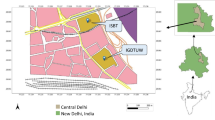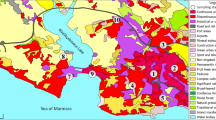Abstract
Aerosol samples were collected during winter fog and nonfog episodes in Beijing. Transmission electron microscopy (TEM) and scanning electron microscopy (SEM) were applied to study morphologies, sizes, and compositions of aerosol particles. TEM observation indicates that most mineral particles collected in fog episode are scavenged in fog droplets. Number–size distributions of mineral particles collected in fog and nonfog episodes show two main peaks at the ranges of 0.1–0.3 and 1–2.5 μm, respectively. Based on their major compositions, mineral particles mainly include Si-rich, Ca-rich, and S-rich. Average S/Ca ratio of mineral particles collected in fog episode is 6.11, being eight times higher than that in nonfog episodes. Development mechanism of individual mineral particles in fog droplets is proposed. It is suggested that mineral particles with abundant alkaline components (e.g., “Ca-rich” particles) occurred in air should alleviate acidic degree of fog and contribute to complexity of fog droplets in Beijing.
Similar content being viewed by others
References
Al-Hosney, H. A., & Grassian, V. H. (2005). Water, sulfur dioxide and nitric acid adsorption on calcium carbonate: A transmission and ATR-FTIR study. Physical Chemistry Chemical Physics, 7(6), 1266–1276. doi:10.1039/b417872f.
Buseck, P. R., Jacob, D. J., Pósfai, M., Li, J., & Anderson, J. R. (2002). Minerals in the air: An environmental perspective. In W. G. Ernst (Ed.), Frontiers in geochemistry: Global inorganic geochemistry (Konrad Krauskopf Vol. 1, International Book Series Vol. 5, pp. 106–122). Geological society of America, Columbia: Bellwether publishing, Ltd. Columbia.
Collett, J. L., Hoag, K. J., & Rao, X. (1999). Internal acid buffering in San Joaquin Valley fog drops and its influence on aerosol processing. Atmospheric Environment, 33(29), 4833–4847. doi:10.1016/S1352-2310(99)00221-6.
Del Monte, M., & Rossi, P. (1997). Fog and gypsum crystals on building materials. Atmospheric Environment, 31(11), 1637–1646. doi:10.1016/S1352-2310(96)00343-3.
He, L. Y., Hu, M., Huang, X. F., Zhang, Y. H., & Tang, X. Y. (2006). Seasonal pollution characteristics of organic compounds in atmospheric fine particles in Beijing. The Science of the Total Environment, 359, 167–176. doi:10.1016/j.scitotenv.2005.05.044.
Hoag, K. J., Collett, J. L., & Pandis, S. N. (1999). The influence of drop size-dependent fog chemistry on aerosol processing by San Joaquin Valley fogs. Atmospheric Environment, 33(29), 4817–4832. doi:10.1016/S1352-2310(99)00268-X.
IPCC (2007). Climate change 2007. The physical science basis. In S. Solomon, D. Qin, M. Manning, Z. Chen, M. Marquis, K. B. Averyt, et al. (Eds.), Contribution of working group I to the fourth assessment report of the intergovernmental panel on climate change. Cambridge, UK: Cambridge University Press.
Kim, B. G., & Park, S. U. (2001). Transport and evolution of a winter-time Yellow sand observed in Korea. Atmospheric Environment, 35(18), 3191–3201. doi:10.1016/S1352-2310(00)00469-6.
Lakhani, A., Parmar, R. S., Satsangi, G. S., & Prakash, S. (2007). Chemistry of fogs at Agra, India: Influence of soil particulates and atmospheric gases. Environmental Monitoring and Assessment, 133(1–3), 435–445. doi:10.1007/s10661-006-9598-6.
Lau, K. M., Ramanathan, V., Wu, G. X., Li, Z., Tsay, S. C., Hsu, C., et al. (2008). The joint aerosol-monsoon experiment—a new challenge for monsoon climate research. Bulletin of the American Meteorological Society, 89(3), 369–383. doi:10.1175/BAMS-89-3-369.
Li, W. J., & Shao, L. Y. (2008). Observation of nitrate coatings on atmospheric mineral dust particles. Atmospheric Chemistry and Physics Discussion, 8(6), 19249–19272.
Lu, S. L., Shao, L. Y., Wu, M. H., Jiao, Z., & Chen, X. H. (2007). Chemical elements and their source apportionment of PM10 in Beijing urban atmosphere. Environmental Monitoring and Assessment, 133, 79–85. doi:10.1007/s0661-006-9561-6.
Minami, Y., & Ishizaka, Y. (1996). Evaluation of chemical composition in fog water near the summit of a high mountain in Japan. Atmospheric Environment, 30(19), 3363–3376. doi:10.1016/1352-2310(96)00029-5.
Nemery, B., Hoet, P. H. M., & Nemmar, A. (2001). The Meuse Valley fog of 1930: An air pollution disaster. Lancet, 357(9257), 704–708. doi:10.1016/S0140-6736(00)04135-0.
Okada, K., & Kai, K. (2004). Atmospheric mineral particles collected at Qira in the Taklamakan desert, China. Atmospheric Environment, 38(40), 6927–6935. doi:10.1016/j.atmosenv.2004.03.078.
Okada, K., Qin, Y., & Kai, K. (2005). Elemental composition and mixing properties of atmospheric mineral particles collected in Hohhot, China. Atmospheric Research, 73(1–2), 45–67. doi:10.1016/j.atmosres.2004.08.001.
Pandis, S. N., & Seinfeld, J. H. (1989). Sensitivity analysis of a chemical mechanism for aqueous-phase atmospheric chemistry. Journal of Geophysical Research—Atmospheres, 94, 1105–1126.
Raja, S., Ravikrishna, R., Kommalapati, R. R., & Valsaraj, K. T. (2005). Monitoring of fogwater chemistry in the gulf coast urban industrial corridor: Baton Rouge (Louisiana). Environmental Monitoring and Assessment, 110(1–3), 99–120. doi:10.1007/s10661-005-6281-2.
Sasakawa, M., Ooki, A., & Uematsu, M. (2003). Aerosol size distribution during sea fog and its scavenge process of chemical substances over the northwestern North Pacific. Journal of Geophysical Research, 108(D3), 13–11. doi:10.1029/2002JD002329.
Seinfeld, J. H. (1986). Atmospheric chemistry and physics of air pollution. New York: Wiley.
Shao, L. Y., Li, W. J., Shi, Z., & Lu, S. (2007). Mineralogical characteristics of individual airborne particles collected in Beijing during a severe Asian dust storm period in spring 2002. Science in China Series D, 50(6), 953–959. doi:10.1007/s11430-007-0035-7.
Shao, L. Y., Li, W. J., Xiao, Z. H., & Sun, Z. Q. (2008). The mineralogy and possible sources of spring dust particles over Beijing. Advances in Atmospheric Sciences, 25, 395–403. doi:10.1007/s00376-008-0395-8.
Shao, L. Y., Shi, Z., Jones, T. P., Li, J., Whittaker, A. G., & BeruBe, K. A. (2006). Bioreactivity of particulate matter in Beijing air: Results from plasmid DNA assay. The Science of the Total Environment, 367(1), 261–272. doi:10.1016/j.scitotenv.2005.10.009.
Shi, Z. B., Shao, L. Y., Jones, T. P., Whittaker, A. G., Lu, S., Berube, K. A., et al. (2003). Characterization of airborne individual particles collected in an urban area, a satellite city and a clean air area in Beijing, 2001. Atmospheric Environment, 37(29), 4097–4108. doi:10.1016/S1352-2310(03)00531-4.
Song, Y., Tang, X. Y., Xie, S. D., Zhang, Y. H., Wei, Y. J., Zhang, M. S., et al. (2007). Source apportionment of PM2.5 in Beijing in 2004. Journal of Hazardous Materials, 146, 124–130. doi:10.1016/j.jhazmat.2006.11.058.
Sun, Y. L., Zhuang, G. S., Tang, A. H., Wang, Y., & An, Z. S. (2006). Chemical characteristics of PM2.5 and PM10 in haze-fog episodes in Beijing. Environmental Science & Technology, 40(10), 3148–3155. doi:10.1021/es051533g.
Takahashi, Y., Kanai, Y., Kamioka, H., Ohta, A., Maruyama, H., Song, Z., et al. (2006). Speciation of sulfate in size-fractionated aerosol particles using sulfur K-edge X-ray absorption near-edge structure. Environmental Science & Technology, 40(16), 5052–5057. doi:10.1021/es060497y.
Uematsu, M., Yoshikawa, A., Muraki, H., Arao, K., & Uno, I. (2002). Transport of mineral and anthropogenic aerosols during a Kosa event over East Asia. Journal of Geophysical Research—Atmospheres, 107(D7–D8), 4059–4067.
Weathers, K. C., Likens, G. E., Bormann, F. H., Eaton, J. S., Bowden, W. B., Andersen, J. L., et al. (1986). A regional acidic cloud/fog water event in the eastern United States. Nature, 319(6055), 657–658. doi:10.1038/319657a0.
Wyzga, R. E., & Folinsbee, L. J. (1995). Health effects of acid aerosols. Water, Air, and Soil Pollution, 85(1), 177–188. doi:10.1007/BF00483699.
Zhang, D. Z., & Iwasaka, Y. (1999). Nitrate and sulfate in individual Asian dust-storm particles in Beijing, China in spring of 1995 and 1996. Atmospheric Environment, 33(19), 3213–3223. doi:10.1016/S1352-2310(99)00116-8.
Zhang, G. Z., Bian, L. G., Wang, J. Z., Yang, Y. Q., Yao, W. Q., & Xu, X. D. (2005). The boundary layer characteristics in the heavy fog formation process over Beijing and its adjacent areas. Science in China Series D, 48, 88–101.
Zhang, X. Y., Gong, S. L., Shen, Z. X., Mei, F. M., Xi, X. X., Liu, L. C., et al. (2003). Characterization of soil dust aerosol in China and its transport and distribution during 2001 ACE-Asia: 1. Network observations—art. no. 4261. Journal of Geophysical Research—Atmospheres, 108(D9), 4261–4261. doi:10.1029/2002JD002632.
Author information
Authors and Affiliations
Corresponding author
Rights and permissions
About this article
Cite this article
Li, W., Shao, L. Characterization of mineral particles in winter fog of Beijing analyzed by TEM and SEM. Environ Monit Assess 161, 565–573 (2010). https://doi.org/10.1007/s10661-009-0768-1
Received:
Accepted:
Published:
Issue Date:
DOI: https://doi.org/10.1007/s10661-009-0768-1




